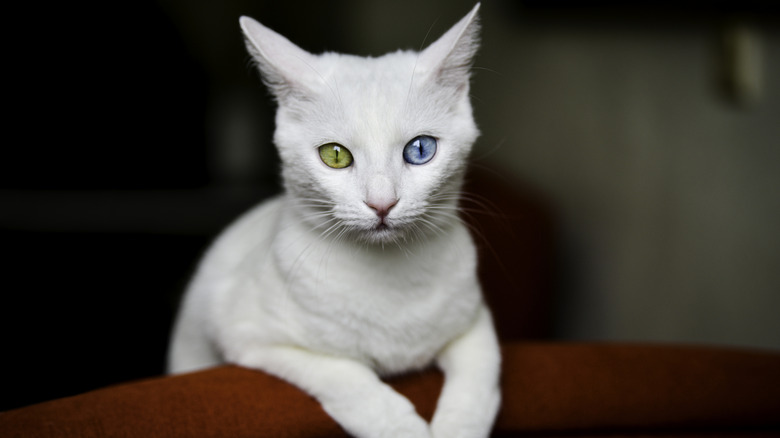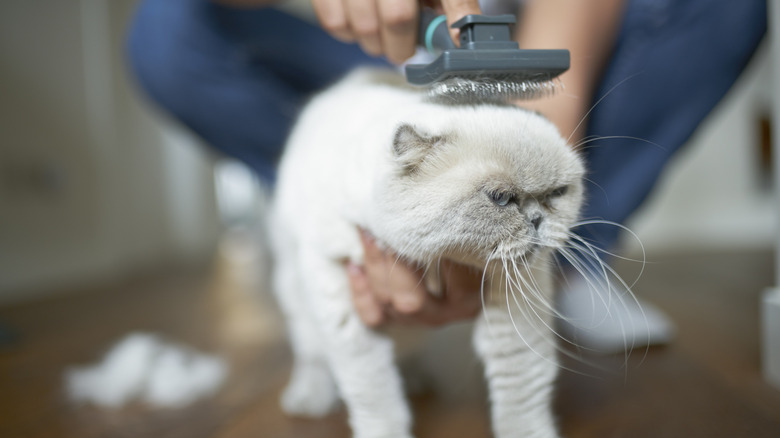The Rarest Cat Color Isn't A Color At All
Feline coats come in a dazzling variety of shades. From sleek black and vibrant orange tabby cat patterns to motley calico and mottled tortoiseshell, these colors provide spectral joy for the eyes. But what determines a cat's coat color? The answer lies in genetics, a.k.a. the complex interplay of inherited traits expressed in a feline's palette and patternization.
Among these colorful cat swatches, one coat stands out for its purity and rarity: white. But it's not the color white that's expressed, nor simply the absence of pigment. Instead, their snowy fur results from a genetic mechanism that masks the expression of other colors. It's also worth noting that there is a difference between a white cat and an albino cat.
White cats owe their unique appearance to the dominant W gene, also known as the white masking gene. This gene works by suppressing the activity of pigmentation genes, effectively concealing any underlying coat colors and patterns. While other cats might display stripes, spots, or swirls, white cats remain a blank canvas. But the story of white cats doesn't end with the W gene. Let's unravel this pearly mystery one gene at a time.
The genetic rarity of white cats
As seen in 2014 research published in G3: Genes, Genomes, Genetics, geneticists have found that another gene, known as KIT, plays a significant role in the development of white coats in cats. KIT influences the migration of pigment-producing cells, or melanocytes, during embryonic development. If these cells fail to reach the skin and fur follicles, the result is a pure-white coat. This process is intricate and not entirely understood, which adds to the mystique surrounding these cats.
Interestingly enough, the same genetic factors that create the special appearances of white cats also contribute to other traits, such as their distinctive eye colors, according to 2024 research published in the journal Animals. Many white cats have striking blue eyes or different-colored eyes (heterochromia). This, too, is linked to the migration of pigment cells during development. If you're curious to learn more, we have previously covered what causes different eye colors in cats.
With their rare genetics, white cats have extensively served as a biomedical model, particularly when it comes to their predisposition to congenital deafness. This condition, tied to the W gene, offers insights into human hearing loss and other genetic disorders. But as beautiful and potentially helpful for research as they are, the rarity of these felines comes with white-hot challenges.
Rarity comes at a price: The unique care requirements of white cats
Research published in Veterinary Clinics of North America: Small Animal Practice shows that up to 80% of blue-eyed white cats experience deafness in one or both ears. This is due to abnormalities in the inner ear caused by the same genetic factors that prevent pigment cell development. White cats with heterochromia — one blue eye and one of another color — may also experience partial deafness.
For owners of such cats, these challenges require special care. Cats with deafness rely more heavily on their other senses, so creating a safe and predictable environment is crucial. Training methods that incorporate visual cues, such as hand signals, can help bridge communication gaps. For white cats with pristine coats, maintaining their appearance can also be a task, as their fur tends to show dirt and stains more easily. Regular grooming and proper care are essential for keeping them healthy and comfortable, so be sure to check out our guidance for keeping a cat's fur white.
Despite their challenges, white cats remain one of the rarest and most coveted types in the feline world. Their elegance, born of complex genetic combinations, makes them a cherished anomaly among cat lovers and geneticists alike — a privilege to own and a responsibility to care for.


